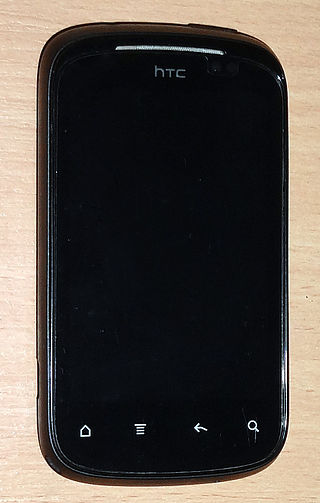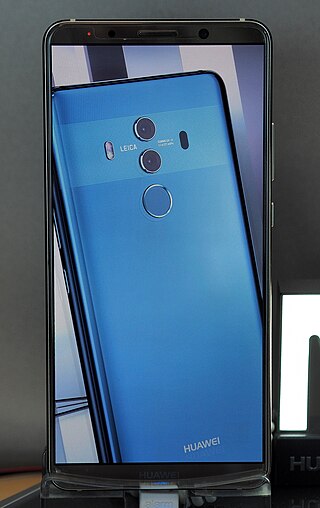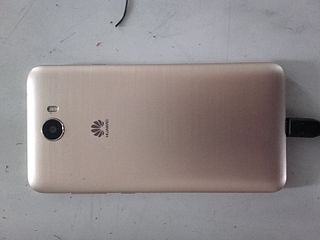Related Research Articles
A mobile operating system is an operating system used for smartphones, tablets, smartwatches, smartglasses, or other non-laptop personal mobile computing devices. While computers such as typical/mobile laptops are "mobile", the operating systems used on them are usually not considered mobile, as they were originally designed for desktop computers that historically did not have or need specific mobile features. This "fine line" distinguishing mobile and other forms has become blurred in recent years, due to the fact that newer devices have become smaller and more mobile, unlike the hardware of the past. Key notabilities blurring this line are the introduction of tablet computers, light laptops, and the hybridization of the two in 2-in-1 PCs.

The T-Mobile Pulse (sold as the CHT8000 in Taiwan) is an Android-powered phone manufactured by Huawei and rebranded by T-Mobile. It is available in many markets including the UK and The Netherlands. Compared to many Android phones released at the time it was relatively low cost - originally selling for £185 in the UK, the Pulse achieved a minimum price of £19.99 + £10 top up on PAYG before being discontinued in April 2011. This made it one of the cheapest Android powered smartphones available at the time. The Pulse was also marketed as being the first Pay As You Go phone running the Android OS.
Rooting is the process by which users of Android devices can attain privileged control over various subsystems of the device, usually smartphones and tablets. Because Android is based on a modified version of the Linux kernel, rooting an Android device gives similar access to administrative (superuser) permissions as on Linux or any other Unix-like operating system such as FreeBSD or macOS.

The HTC Explorer, code-named Pico, is a smartphone developed by the HTC Corporation that was released in October 2011. Because of the low end processor, the HTC Watch movie rental service and the 3D scrolling effects on the home screens were not available. The handset was available in four varieties of color options. Visually similar to the HTC Wildfire S, it comes with a 3.2-inch screen, a 600 MHz ARMv7 Qualcomm Snapdragon processor and runs Android version 2.3 (Gingerbread), bundled with the proprietary HTC Sense 3.5 user interface.

Nexus 6P is an Android smartphone developed and marketed by Google and manufactured by Huawei. It succeeded the Nexus 6 as the flagship device of the Nexus line of Android devices by Google and was the final Nexus before Google switched to the Pixel lineup. Officially unveiled on 29 September 2015 along with the Nexus 5X at the Google Nexus 2015 press event held in San Francisco, it was made available for pre-order on the same day in United States, United Kingdom, Ireland, and Japan.

Huawei Mate, formally Huawei Ascend Mate, is a series of high-end HarmonyOS-powered smartphones produced by Huawei, and is one of their flagship products along with the Pura series.

The Huawei Mate 10, Huawei Mate 10 Pro and Huawei Mate 10 Lite are Android smartphones designed and marketed by Huawei as part of the Huawei Mate series. There is also a Mate 10 Porsche design, which has 256 GB of storage but is otherwise identical to the Mate 10 Pro. They were first released on 16 October 2017. Versus the predecessor Mate 9, the Mate 10 pro flagship phone has a faster processor with an integrated neural processing unit, a slightly larger OLED screen (6.0") with a taller 18:9 aspect ratio, a significantly longer battery life and a glass back construction. Chinese and international models are available in dual SIM configuration. It comes with Android 8 and a newer version of Huawei's EMUI interface. All Mate 10 models are unlocked and GSM only. Huawei phones, including the Mate series, are not sold or financed through U.S. carriers due to pressure from U.S. intelligence agencies, though they are available from independent and online retailers.

The Huawei Pura series is a line of high-end and medium-range smartphones produced by Huawei, based on its proprietary HarmonyOS mobile operating system. The P series was formerly marketed as part of Huawei's larger Ascend brand, and some models were called P smart.
HarmonyOS (HMOS) is a distributed operating system developed by Huawei for smartphones, tablets, smart TVs, smart watches, personal computers and other smart devices. It has a microkernel design with single framework: the operating system selects suitable kernels from the abstraction layer in the case of devices that use diverse resources.

Bootloader unlocking is the process of disabling the bootloader security that makes secure boot possible. It can make advanced customizations possible, such as installing custom firmware. On smartphones, this can be a custom Android distribution or another mobile operating system. Some bootloaders are not locked at all and some are locked, but can be unlocked with a command or with assistance from the manufacturer. Some do not include an unlocking method and can only be unlocked through a software exploit.

The Huawei P50 and P50 Pro are HarmonyOS-based high-end smartphones manufactured by Huawei. Unveiled on 21 July 2021, they succeed the Huawei P40 in the P series. In March 2023 Huawei released their successor Huawei P60 Series phones in China, and in May 2023 it released the Huawei P60 Pro in Europe.
Xiaomi MIX Fold 2 is an Android-based foldable smartphone manufactured by Xiaomi. For the first time in the MIX Fold series, the phone developed in partnership with Leica camera, it was announced on August 11, 2022.
The Redmi 7 is an Android-based smartphone as part of the Redmi series, a sub-brand of Xiaomi Inc. It was announced on March 18, 2019 and it was released on March 20, 2019.

The Huawei Y3, also known as Huawei Y360, is an Android smartphone developed by Huawei and it belongs to the Y series. It was announced in March 2015 and released in June 2015.

The Huawei Y5 II is an Android phone developed from the company Huawei. It was announced in April 2016 and released in June of the same year.
Huawei Y6 II is a smartphone developed by Huawei. In India, the smartphone was introduced as Honor Holly 3, while in Malaysia, it was known as Honor 5A ."
The Huawei Y3 (2017) is an Android smartphone from the Huawei Y series developed by Huawei. It was introduced by in June 2017 and later released in September 2017.

The Huawei Y5 (2017) is an Android smartphone from the Y series manufactured and developed by Huawei. It was announced in April 2017, and was released in June.
The Huawei Y3 (2018) is an entry-level of Android smartphone developed by Huawei, notable for its use of a special lightweight version of Android called Android Go. It was unveiled on May 9, 2018.
References
- ↑ "Huawei Y3II - Full phone specifications". www.gsmarena.com. Retrieved 2024-12-30.
- ↑ "Обзор Huawei Y3II – смартфон с программируемой кнопкой и "умным" LED-индикатором за $77". www.smartphone.ua (in Ukrainian). Retrieved 2024-12-30.
- ↑ "Огляд Huawei Y3 II: бюджетно-східний маяк - Root Nation". root-nation.com (in Ukrainian). September 22, 2016. Retrieved 2024-12-30.
- ↑ "≡ Huawei Y3 II Dual Gold – купить Huawei Y3 II". www.moyo.ua (in Russian). Archived from the original on February 9, 2019. Retrieved 2024-12-30.
